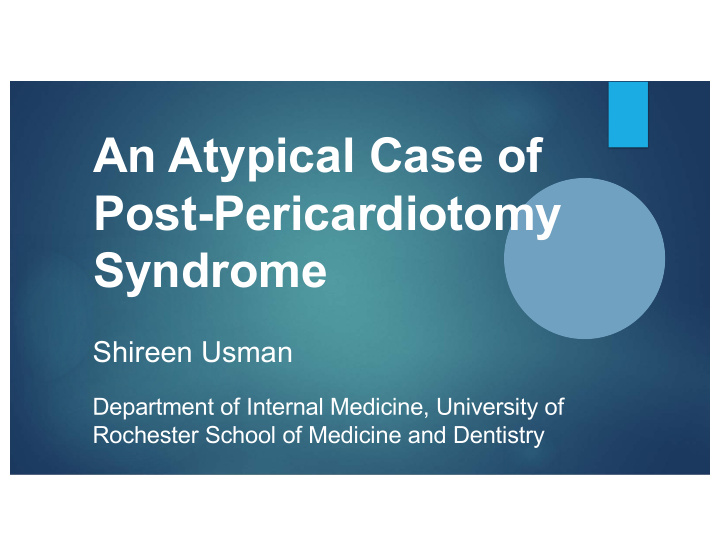



An Atypical Case of Post-Pericardiotomy Syndrome Shireen Usman Department of Internal Medicine, University of Rochester School of Medicine and Dentistry
Background Post-pericardiotomy syndrome (PPCS) occurs secondary to pericardial injury o generally post-cardiac procedure (valve replacement, PCI, PPM, RF ablation) Occurs in a large percentage of patients (10-40%) who have undergone o cardiothoracic surgery Frequently underdiagnosed because it is a clinical diagnosis which typically o presents after patient discharge Contributes significantly to post-op morbidity, prolonged hospital stays, o readmissions Presents with fever, pleuritic chest pain, pericardial rub, elevated c-reactive o protein (CRP) and pericardial/pleural effusions. Unilateral pleural effusions are reported in a minority of patients with PPCS o This is an unusual case of PPCS that presented with primarily pulmonary o symptoms and a large R pleural effusion which was refractory to initial treatment and ultimately required therapeutic drainage
Case Presentation u A 65-year-old man with a 22-pack- year smoking history, severe aortic stenosis, and recent bioprosthetic aortic valve replacement presented with worsening dyspnea, productive cough, fever, and night sweats.
Aortic Valve Replacement Clinical Course Begins to develop Week 3 progressive SOB, cough, and fevers (101F) Treated for pneumonia Week 4 Outpatient CT chest with no improvement angiogram shows large pericardial effusion and Cardiologist starts mild moderate pleural - Week 6 colchicine 0.6 mg BID + effusions ibuprofen 600 mg TID Week 7 Rapid improvement Recurrence of fevers, Week 8 cough, dyspnea Repeat CT chest with Hospital WBC 11.8, Plts 408, CRP improving pericardial 167, ESR 126 Admission effusion but increased R pleural effusion Undergoes R Pleural fluid analysis thoracentesis with consistent with 800cc of cloudy exudative effusion serous fluid removed Started on prolonged course of prednisone 15 mg Repeat CXR with no Resolution of symptoms Week 12 evidence of pleural effusion Continue CRP 87, ESR 24 prednisone 20 mg Week 14 CRP < 1
Conclusions Post-cardiac injury syndrome: o PPCS o Post-MI syndrome (Dresser syndrome) o Post-traumatic pericarditis o Characterized by pericarditis - pleuritic chest pain in >80% of patients o Exudative pleural effusions observed in PPCS, but 85% are small and left-sided o A unique case of PPCS in a patient who presented without chest pain and was o found to have a predominantly large right-sided pleural effusion refractory to first-line treatment Diagnosis was complicated by a clinical picture suspicious for pneumonia o versus malignancy Symptomatic improvement in this case was ultimately achieved with systemic o glucocorticoid therapy and therapeutic thoracentesis
Recommend
More recommend